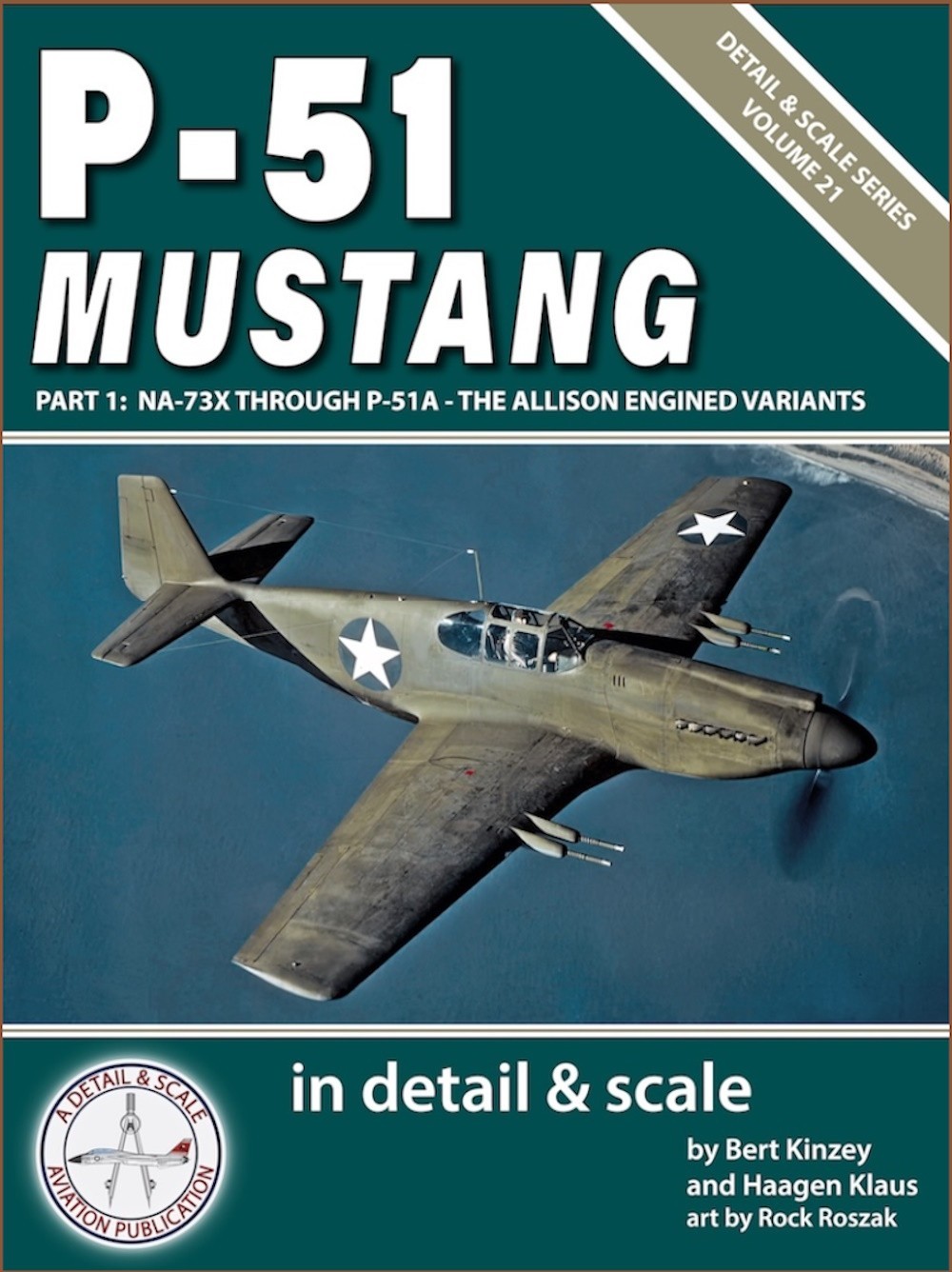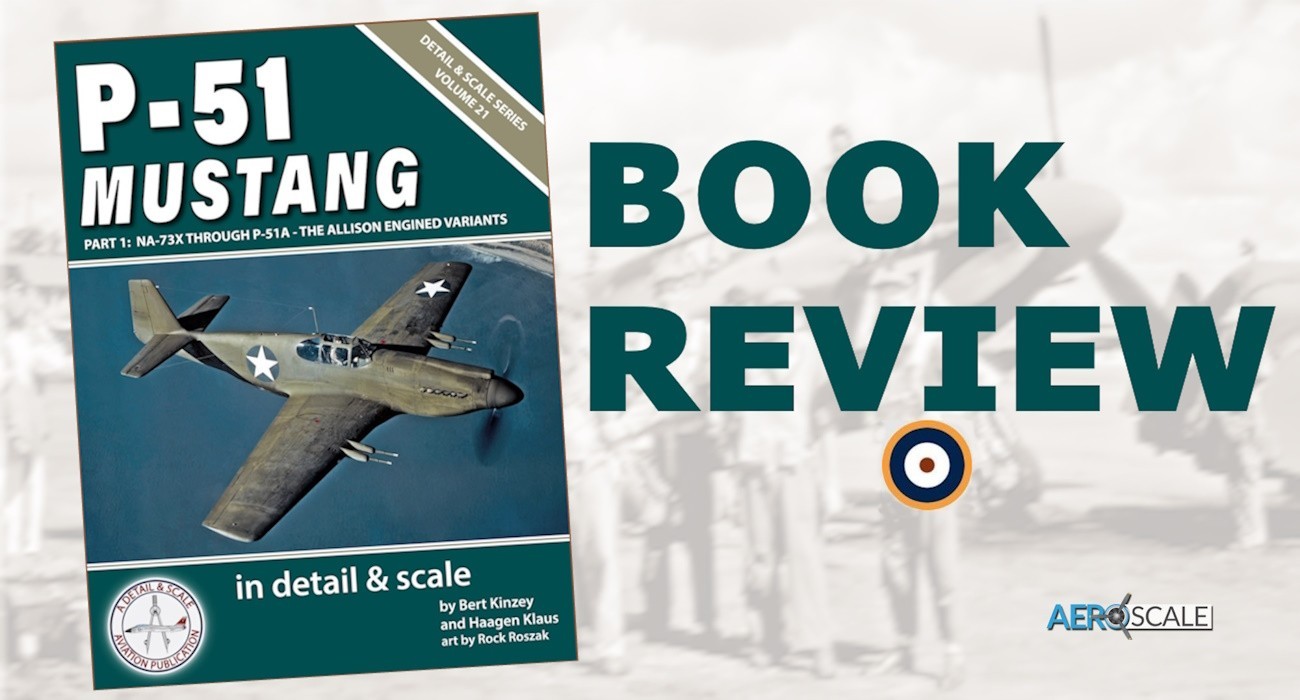
After almost thirty years, Detail & Scale is revamping their excellent two-volume coverage of North American’s legendary fighter, the P-51 Mustang. With new research, new kits to cover, fresh photos, and better printing technology, these books show tremendous promise. But the best part? The oft-neglected Allison-powered Mustangs get their own volume.
The early Mustangs—the prototype (NA-73X), the XP-51 airframes delivered to the USAAF, the early Mk.1 and P-51 aircraft delivered to the RAF, the P-51A which did yeoman’s work well past its prime in southeast Asia, and others—are sadly neglected by researchers, model manufacturers, and the general public. This has always been particularly frustrating for myself, since, in my opinion, the pre-Merlin Mustangs are some of the most beautiful airplanes to come out of this era of aviation development. Therefore, I was particularly excited to see that Detail & Scale wasn’t just updating their range, but expanding it.
They did not disappoint. Bert Kinzey, Haagen Klaus, and Rock Roszak have vastly improved on the previous, already-impressive work and offered something that is a must-have for any fan of the Mustang generally, but particularly so for those with a soft spot for the best—and dare I say…purest?—variants of North American’s most famous fighter. Therefore, call me biased, but I loved this book. But don’t worry, that opinion is based in real reasons. Here’s why you need this book.
First, the book expands our knowledge base on the Mustang. The depth and quality of the research these authors put together is impressive, and the introduction outlines it well. Not only did they photograph real aircraft (and not backdated Merlin airframes made to look like A-models, but actual A-model Mustangs), but they also secured the help and contributions of at least three significant photo collectors—Stan Piet, Gerald Balzer, and Dana Bell. This collaboration shows immediately upon opening the book, and was the first thing I noticed.
The pictures are impressive, and impressive in two ways. First, they have collected images that don’t usually make it into your typical Mustang histories (particularly when they devote a scant few pages to the pre-Merlin variants). Second, the picture quality is top-notch. Let me explain.
I don’t claim to be an expert on the Mustang (or anything, really), but I have made a concerted effort to collect as many books on the Mustang—and the Allison variants in particular—as possible. As a result, I have a library of books which often feel like they are 40% duplicates of each other as far as photographs are concerned. To be honest, I was a little worried this book would be the same. But it isn’t. For example, the prototype Mustang, referred to by its North American design name, NA-73X, is a plane of particular interest to me. (I’m personally—as time allows—working toward building a 1/48 lineup of every major Mustang variant and obviously that airframe is key to the project.) There are pictures here I’ve never seen before in any other history of the plane. For example, on page 7, there is a picture of the crashed airframe back in the North American hangar, mauled after its ill-fated 8th test flight. That’s one I’d never seen. Then there’s a picture of the completed plane conducting run-up checks on the NAA ramp—another one I’d never seen. Not only that, but that photo completely upended—and resolved—my previous lengthy research about whether the first, pre-crash airframe had gun fairings under the nose. Spoiler alert: it did. I’d concluded otherwise based on every other picture I’d seen.
They don’t call it “Detail & Scale” for nothing.
Kinzey, Klaus, and Roszak also assembled an impressive array of color photos. My personal library includes as many of photo collection books as I’ve been able to find, yet nearly every color photo here was new to me. Now I’ll admit again that I’m no expert, and my library (and the Ethell collection) isn’t the end of the matter as far as Mustangs go, but I’m certain that you’ll have a similar experience to me. It’s as if the authors wrote the book under the mission statement: “Cover the Allison Mustangs without using any pictures anyone else has used.” That overstates it a bit, but they sure came close.
Finally, the pictures are of great quality. Some readers may be concerned with the print quality of a print-on-demand book like this (more on that later). No need to worry here. The new pictures were of great quality, the familiar pictures were of better quality, and I only found one image which I’d seen better quality online. I think you’ll be pleased.
This entire series highlights another element of research-based hobbies like ours that is increasingly lost in our digital, social media world: the value of real, serious research. Denizens of internet forums love to debate what color the wheel wells of a Mustang should be, or whether the cockpit color was more or less brownish or greenish green. Usually, such debates center around low-quality photos pulled from websites or scanned from books with attempts to edit the photos with Photoshop or editing apps to arrive at the right answer. Admittedly, that’s often the best we can do.
Then, Detail & Scale steps in and provides color photos and original source research and photos of (accurate!) restorations and settles the question (or provides fodder for debate, depending on your perspective!). That’s exactly why we buy books like this.
Finally, the book ends with an in-depth discussion of the model kits available in 1/144, 1/72, 1/48, and 1/32 scale. It was good reading and a helpful overview. Unfortunately, however, it mostly serves to highlight how much kit makers have neglected the Allison-engine Mustangs, particularly in 1/32 scale (Hey Kotare…how about a P-51A kit next?). Obviously, that’s nothing to hold against the authors, and the built-up kits (mostly constructed by the authors themselves) are top-notch. I think I need to buy Halberd’s XP-51 conversion—Klaus did an excellent job with his.
The book is available from Detail & Scale in two formats: print-on-demand and e-book. Personally, I vastly prefer real, print books, but I’m an old soul. The e-book definitely has its place and would presumably allow for more detailed examination of the many excellent photos in the book. Your choice; but don’t feel like the print copy is of anything less than great quality.
The substance of the book is right at 100 pages. The first half of the book covers the history and historical photos, and the second half lays out the detail photos and hard research. Rock Roszak’s excellent scale drawings and color profiles grace the book’s pages throughout, and provide a helpful visualization of the black-and-white aircraft shown.
In summary, if you hold even a passing interest in America’s most famous propeller-driven fighter, you won’t regret buying this book. Based on volume 1, I have high hopes for volumes 2-3, which will cover the Merlin and later variants. Stay tuned.

